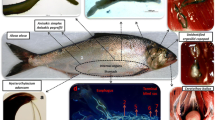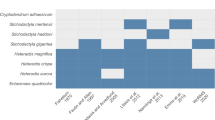Abstract
Marine phytomyxids represent often overlooked obligate biotrophic parasites colonizing diatoms, brown algae, and seagrasses. An illustrative example of their enigmatic nature is the phytomyxid infecting the seagrass Halophila stipulacea (a well-known Lessepsian migrant from the Indo-Pacific to the Mediterranean Sea). In the Mediterranean, the occurrence of this phytomyxid was first described in 1995 in the Strait of Messina (southern Italy) and the second time in 2017 in the Aegean coast of Turkey. Here we investigated, using scuba diving, stereomicroscopy, light and scanning electron microscopy, and molecular methods, whether the symbiosis is still present in southern Italy, its distribution in this region and its relation to the previous reports. From the total of 16 localities investigated, the symbiosis has only been found at one site. A seasonal pattern was observed with exceptionally high abundance (> 40% of the leaf petioles colonized) in September 2017, absence of the symbiosis in May/June 2018, and then again high infection rates (~ 30%) in September 2018. In terms of anatomy and morphology as well as resting spore dimensions and arrangement, the symbiosis seems to be identical to the preceding observations in the Mediterranean. According to the phylogenetic analyses of the 18S rRNA gene, the phytomyxid represents the first characterized member of the environmental clade “TAGIRI-5”. Our results provide new clues about its on-site ecology (incl. possible dispersal mechanisms), hint that it is rare but established in the Mediterranean, and encourage further research into its distribution, ecophysiology, and taxonomy.





Similar content being viewed by others
References
Ugarelli K, Chakrabarti S, Laas P, Stingl U (2017) The seagrass holobiont and its microbiome. Microorganisms 5:81
Jensen SI, Kühl M, Priemé A (2007) Different bacterial communities associated with the roots and bulk sediment of the seagrass Zostera marina. FEMS Microbiol Ecol 62:108–117
Garcias-Bonet N, Arrieta JM, de Santana CN, Duarte CM, Marbà N (2012) Endophytic bacterial community of a Mediterranean marine angiosperm (Posidonia oceanica). Front Microbiol 3:342
Cúcio C, Engelen AH, Costa R, Muyzer G (2016) Rhizosphere microbiomes of European seagrasses are selected by the plant but are not species specific. Front Microbiol 7:440
Fahimipour AK, Kardish MR, Lang JM, Green JL, Eisen JA, Stachowicz JJ (2017) Global-scale structure of the eelgrass microbiome. Appl Environ Microbiol 83:e03391–e03316
Mata JL, Cebrián J (2013) Fungal endophytes of the seagrasses Halodule wrightii and Thalassia testudinum in the northcentral Gulf of Mexico. Bot Mar 56:541–545
Venkatachalam A, Thirunavukkarasu N, Suryanarayanan TS (2015) Distribution and diversity of endophytes in seagrasses. Fungal Ecol 13:60–65
Vohník M, Borovec O, Kolařík M (2016) Communities of cultivable root mycobionts of the seagrass Posidonia oceanica in the northwest Mediterranean Sea are dominated by a hitherto undescribed pleosporalean dark septate endophyte. Microb Ecol 71:442–451
Vohník M, Borovec O, Župan I, Kolařík M, Sudová R (2017) Fungal root symbionts of the seagrass Posidonia oceanica in the central Adriatic Sea revealed by microscopy, culturing and 454-pyrosequencing. Mar Ecol Progr Ser 583:107–120
Neuhauser S, Kirchmair M, Gleason FH (2011) Ecological roles of the parasitic phytomyxids (plasmodiophorids) in marine ecosystems - a review. Mar Freshwater Res 62:365–371
Mateu-Vicens G, Khokhlova A, Sebastián-Pastor T (2014) Epiphytic foraminiferal indices as bioindicators in Mediterranean seagrass meadows. J Foram Res 44(3):325–339
Man in’t Veld WA, Rosendahl KC, van Rijswick PC, Meffert JP, Boer E, Westenberg M, van der Heide T, Govers LL (2019) Multiple Halophytophthora spp. and Phytophthora spp. including P. gemini, P. inundata and P. chesapeakensis sp. nov. isolated from the seagrass Zostera marina in the Northern hemisphere. Eur J Plant Pathol 153(2):341–357
Muehlstein LK, Porter D, Short FT (1991) Labyrinthula zosterae sp. nov., the causative agent of wasting disease of eelgrass, Zostera marina. Mycologia 83:180–191
Ralph PJ, Short FT (2002) Impact of the wasting disease pathogen, Labyrinthula zosterae, on the photobiology of eelgrass Zostera marina. Mar Ecol Progr Ser 226:265–271
Neuhauser S, Gleason FH, Kirchmair M (2012) Phytomyxea (Super-group Rhizaria). In: Gareth Jones EB, Pang K-L (eds) Marine fungi and fugal-like organisms. De Gruyter, Berlin, pp 245–249
Neuhauser S, Kirchmair M, Bulman S, Bass D (2014) Cross-kingdom host shifts of phytomyxid parasites. BMC Evol Biol 14:33
Sullivan BK, Trevathan-Tackett SM, Neuhauser S, Govers LL (2018) Host-pathogen dynamics of seagrass diseases under future global change. Mar Pollut Bull 134:75–88
den Hartog C (1965) Some notes on the distribution of Plasmodiophora diplantherae, a parasitic fungus on species of Halodule. Persoonia 4:15–18
den Hartog C (1989) Distribution of Plasmodiophora bicaudata, a parasitic fungus on small Zostera species. Dis Aquat Organ 6:227–229
Bulman S, Braselton JP (2014) Rhizaria: Phytomyxea. In: McLaughlin DJ, Spatafora JW (eds) The Mycota VII Part A, Systematics and evolution2nd edn. Springer-Verlag, Berlin, pp 783–803
Feldmann G (1954) La végétation de l’etang de Salses (riv sud). Vie Milieu 4:685–700
Feldmann G (1956) Développement d’une plasmodiophorale marine: Plasmodiophora bicaudata J. Feldm., parasite du Zostera nana Roth. Revue Gen Bot 63:390–421
Lipkin Y (1975) Halophila stipulacea, a review of a successful immigration. Aquat Bot 1:203–215
Marziano F, Villari R, Tripodi G (1995) A plasmodiophorid fungal parasite of the seagrass Halophila stipulacea. Mycotaxon 55:165–170
Vohník M, Borovec O, Özgür Özbek E, Okudan Alsan E (2017) Rare phytomyxid infection on the alien seagrass Halophila stipulacea in the southeast Aegean Sea. Mediterr Mar Sci 18:433–442
Gambi MC, Barbieri F, Bianchi CN (2009) New record of the alien seagrass Halophila stipulacea (Hydrocharitaceae) in the western Mediterranean: a further clue to changing Mediterranean Sea biogeography. Mar Biodivers Rec 2:e84
Gambi MC, Gaglioti M, Barbieri F (2018) Sometimes they come back: the re-colonization of the alien seagrass Halophila stipulacea (Forsskål) Ascherson, 1867 (Hydrocharitaceae) in the Palinuro Harbor (Tyrrhenian Sea, Italy). Bioinvasions Rec 7:215–221
Feldmann J (1940) Une nouvelle espece de Plasmodiophora (P. bicaudata) parasite du Zostera nana Roth. Bull Soc Hist nat Afr Nord 31:171–177
Ferdinandsen, C, Winge Ö (1913) Plasmodiophora halophilae sp. n. Zentralblatt für Bakteriologie, Parasitenkunde, und Infektionskrankheiten 37:167
Cook WRI (1933) A monograph of the Plasmodiophorales. Arch Protistenkd 80:179–254
Dick MW (2001) Straminopilous fungi: systematics of the peronsoporomycetes including accounts of the marine straminipilous protists, the plasmodiophorids and similar organisms. J Gen Virol 75:3585–3590
Goebel K (1884) Tetramyxa parasitica. Flora 67:517–521
Kornaś J (1953) Tetramyxa parasitica Goebel w zatoce Gdanśkiej. Fragm Flor et Geobot 1:12–15
den Hartog C (1963) Tetramyxa parasitica, een gal op Ruppia. Gorteria 1:138–140
Braselton JP (2019) Plasmodiophorid Home Page. https://people.ohio.edu/braselto/plasmodiophorids/. Accessed on 1st March 2019
Famà P, Acunto S, Camilli L, Maltagliati F, Procaccini G (1999) Genetic variation in two Mediterranean populations of Halophila stipulacea (Forssk.) Aschers. Biol Mar Mediterr 6:184–190
Di Martino V, Blundo MC, Tita G (2006) The Mediterranean introduced seagrass Halophila stipulacea in eastern Sicily (Italy): temporal variations of the associated algal assemblage. Vie Milieu 56:223–230
Vohník M, Borovec O, Župan I, Vondrášek D, Petrtýl M, Sudová R (2015) Anatomically and morphologically unique dark septate endophytic association in the roots of the Mediterranean endemic seagrass Posidonia oceanica. Mycorrhiza 25:663–672
Medlin L, Elwood HJ, Stickel S, Sogin ML (1988) The characterization of enzymatically amplified eukaryotic 16S-like rRNA-coding regions. Gene 71(2):491–499
Marande W, López-García P, Moreira D (2009) Eukaryotic diversity and phylogeny using small-and large-subunit ribosomal RNA genes from environmental samples. Environ Microbiol 11(12):3179–3188
Elwood HJ, Olsen GJ, Sogin ML (1985) The small-subunit ribosomal RNA gene sequences from the hypotrichous ciliates Oxytricha nova and Stylonychia pustulata. Mol Biol Evol 2:399–410
Katoh K, Misawa K, Kuma KI, Miyata T (2002) MAFFT: a novel method for rapid multiple sequence alignment based on fast Fourier transform. Nucleic Acids Res 30(14):3059–3066
Hall TA (1999) Bioedit: a user-friendly biological sequence alignment editor and analysis program for Windows 95/98/NT. Nucleic Acids Symp Ser 41:95–98
Stamatakis A (2014) RAxML version 8: a tool for phylogenetic analysis and post-analysis of large phylogenies. Bioinformatics 30:1312–1313
Ronquist F, Teslenko M, van der Mark P, Ayres DL, Darling A, Hohna S, Larget B, Liu L, Suchard MA, Huelsenbeck JP (2012) MrBayes 3.2: efficient Bayesian phylogenetic inference and model choice across a large model space. Syst Biol 61:539–542
Bignami F, Salusti E (1990) Tidal currents and transient phenomena in the Strait of Messina: a review. In: Pratt LJ (ed) The physical oceanography of sea straits. Springer, Dordrecht, pp 95–124
Murúa P, Goecke F, Westermeier R, van West P, Küpper FC, Neuhauser S (2017) Maullinia braseltonii sp. nov. (Rhizaria, Phytomyxea, Phagomyxida): a cyst-forming parasite of the bull kelp Durvillaea spp. (Stramenopila, Phaeophyceae Fucales). Protist 168:468–480
Willette DA, Chalifour J, Debrot AOD, Engel MS, Miller J, Oxenford HA et al (2014) Continued expansion of the trans-Atlantic invasive marine angiosperm Halophila stipulacea in the Eastern Caribbean. Aquat Bot 112:98–102
Jiang R, Wang JX, Yu KC, Liu MH, Shi G, Liu XZ (2016) Micro-eukaryotic diversity in the surface layer of sediments from the East China Sea. Evol Ecol Res 17(1):125–140
Takishita K, Miyake H, Kawato M, Maruyama T (2005) Genetic diversity of microbial eukaryotes in anoxic sediment around fumaroles on a submarine caldera floor based on the small-subunit rDNA phylogeny. Extremophiles 9(3):185–196
Anonymous (2014) https://floramalesiana.biowikifarm.net/wiki/Jensen,_Hjalmar. Accessed on 7th December 2018
Karling JS (1968) The Plasmodiophorales, Second completely revised edition. Hafner Publishing Company, New York
Tur NM, Vobis G, Gabellone NA (1984) Presencia de Tetramyxa parasitica (Plasmodiophoraceae) en dos especies de Potamogeton (Potamogetonaceae). Revista del Museo de La Plata (nueva serie). Sección Botánica 13(82):239–246
Buczacki ST, Ockendon JG (1978) A method for the extraction and enumeration of resting spores of Plasmodiophora brassicae from infested soil. Ann Appl Biol 88:363–367
Takahashi K, Yamaguchi T (1987) An improved method for estimating the number of resting spores of Plasmodiophora brassicae in soil. Ann Phytopath Soc Japan 53:507–515
Walker AK, Campbell J (2009) First records of the seagrass parasite Plasmodiophora diplantherae from the Northcentral Gulf of Mexico. Gulf Caribb Res 21:63–65
Elliott JK, Simpson H, Teesdale A, Replogle A, Elliott M, Coats K, Chastagner G (2019) A novel phagomyxid parasite produces sporangia in root hair galls of eelgrass (Zostera marina) 170:64–81
Acknowledgments
The authors acknowledge Gabriele Procaccini for the mediation of our cooperation in the beginning of this wonderful journey, Ondřej Borovec for the preparation of the permanent slides, Michael Kotyk for his help and brilliant ideas in the molecular procedures and Jiří Machač for the assistance during photographic documentation.
Funding
This study was supported by the Grant Agency of Charles University (project GAUK 1308218) and constitutes a part of long-term research projects of the Czech Academy of Sciences, Institute of Botany (RVO 67985939), and Charles University, Faculty of Science (MŠMT LO1417).
Author information
Authors and Affiliations
Corresponding author
Electronic supplementary material
ESM 1
(FAS 70 kb)
Rights and permissions
About this article
Cite this article
Kolátková, V., Čepička, I., Gargiulo, G.M. et al. Enigmatic Phytomyxid Parasite of the Alien Seagrass Halophila stipulacea: New Insights into Its Ecology, Phylogeny, and Distribution in the Mediterranean Sea. Microb Ecol 79, 631–643 (2020). https://doi.org/10.1007/s00248-019-01450-3
Received:
Accepted:
Published:
Issue Date:
DOI: https://doi.org/10.1007/s00248-019-01450-3




